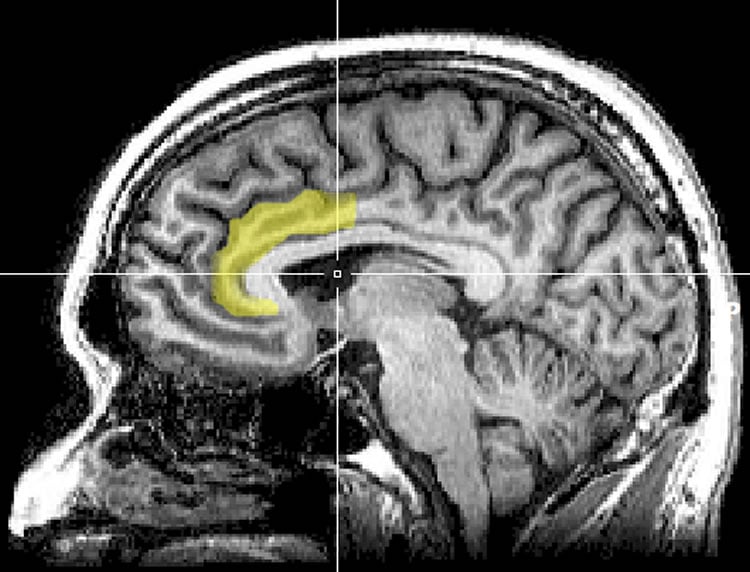People prone to seeking stimulation and acting impulsively may have differences in the structure of their brains according to a study published in the April 6 issue of the Journal of Neuroscience. What’s more, those differences may predispose them to substance abuse.
Avram Holmes, a psychologist at Yale University, and a team of researchers from Harvard University and Massachusetts General Hospital in Boston, found that increased impulsivity and sensation-seeking in healthy young adults was linked to distinct differences in their brain structures: the areas involved in decision-making and self-control had a thinner cortex, the brain’s wrinkled outer layer or gray matter.
This study builds on well-established links between impulsivity, sensation-seeking, and substance abuse. Prior research indicates genes play a role in these behaviors. Other studies conclude substance use can affect brain anatomy and function over time. Scientists don’t know the extent to which brain abnormalities, present prior to drug-taking, contribute to the likelihood that a person will develop a substance abuse disorder.
Holmes and colleagues examined the variability in brain structure among 1,234 males and females aged 18 to 35 with no history of psychiatric disorders or substance dependence. Using magnetic resonance imaging (MRI), the team measured the size of particular regions of the brain for each participant. The participants also completed questionnaires assessing traits associated with sensation-seeking and impulsivity such as their need for novel and intense experiences, willingness to take risks, and a tendency to make rapid decisions. The participants also reported alcohol, tobacco, and caffeine usage.
They found that people who reported seeking high levels of stimulation or excitement had reduced cortical thickness, or gray matter, in brain regions associated with decision making and self-control. The strongest links occurred in brain areas related to the ability to regulate emotions and behavior, the anterior cingulate and middle frontal gyrus. Changes in those brain structures also correlated with participants’ self-reported tendency to act on impulse and with heightened use of alcohol, tobacco, or caffeine.

“The findings allow us to have a better understanding of how normal variation in brain anatomy in the general population might bias both temperamental characteristics and health behaviors, including substance abuse,” Holmes said.
Kristine Beate Walhovd, a professor of neuropsychology at the University of Oslo in Norway who was not involved in the study, agreed. “A strength of the study is that they identify this relationship within non-substance using participants, implying that these variations are not merely the consequence of individual history of substance use,” she added.
The significance of individual variability in brain anatomy is still a subject of debate in the field, Holmes added. He plans to continue to examine how shifts in both brain anatomy and function might affect these and other behaviors associated with risk for psychiatric illness and poor health outcomes.
Source: Lisa Chiu – Society for Neuroscience
Image Credit: The image is credited to Geoff B Hall and is in the public domain.
Original Research: Abstract for “Individual Differences in Cognitive Control Circuit Anatomy Link Sensation Seeking, Impulsivity, and Substance Use” by Avram J. Holmes, Marisa O. Hollinshead, Joshua L. Roffman, Jordan W. Smoller, and Randy L. Buckner in Journal of Neuroscience. Published online April 6 2016 doi:10.1523/JNEUROSCI.3206-15.2016
Abstract
Individual Differences in Cognitive Control Circuit Anatomy Link Sensation Seeking, Impulsivity, and Substance Use
Individuals vary widely in their tendency to seek stimulation and act impulsively, early developing traits with genetic origins. Failures to regulate these behaviors increase risk for maladaptive outcomes including substance abuse. Here, we explored the neuroanatomical correlates of sensation seeking and impulsivity in healthy young adults. Our analyses revealed links between sensation seeking and reduced cortical thickness that were preferentially localized to regions implicated in cognitive control, including anterior cingulate and middle frontal gyrus (n = 1015). These associations generalized to self-reported motor impulsivity, replicated in an independent group (n = 219), and correlated with heightened alcohol, tobacco, and caffeine use. Critically, the relations between sensation seeking and brain structure were evident in participants without a history of alcohol or tobacco use, suggesting that observed associations with anatomy are not solely a consequence of substance use. These results demonstrate that individual differences in the tendency to seek stimulation, act on impulse, and engage in substance use are correlated with the anatomical structure of cognitive control circuitry. Our findings suggest that, in healthy populations, covariation across these complex multidimensional behaviors may in part originate from a common underlying biology.
SIGNIFICANCE STATEMENT Impaired cognitive control may result in a tendency to seek stimulation impulsively and an increased risk for maladaptive outcomes, including substance abuse. Here, we examined the structural correlates of sensation seeking and impulsivity in a large cohort of healthy young adults. Our analyses revealed links between sensation seeking and reduced cortical thickness that were preferentially localized to regions implicated in cognitive control, including anterior cingulate and middle frontal gyrus. The observed associations generalized to motor impulsivity, replicated in an independent group, and predicted heightened alcohol, tobacco, and caffeine use. These data indicate that normal variability in cognitive control system anatomy predicts sensation seeking and motor impulsivity in the healthy populations, potentially increasing risk for substance use disorders.
“Individual Differences in Cognitive Control Circuit Anatomy Link Sensation Seeking, Impulsivity, and Substance Use” by Avram J. Holmes, Marisa O. Hollinshead, Joshua L. Roffman, Jordan W. Smoller, and Randy L. Buckner in Journal of Neuroscience. Published online April 6 2016 doi:10.1523/JNEUROSCI.3206-15.2016







